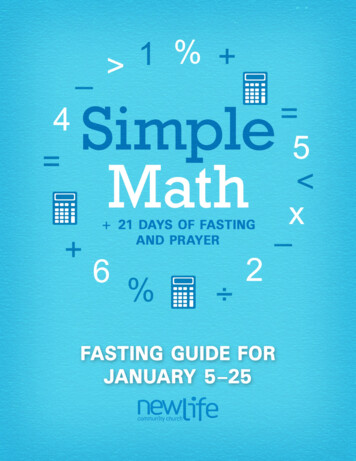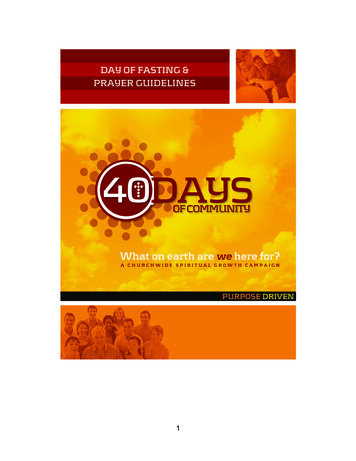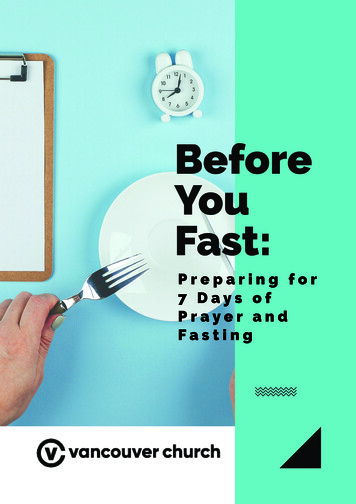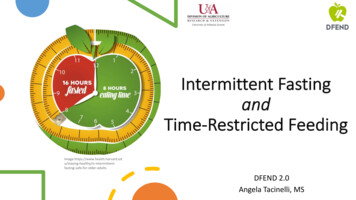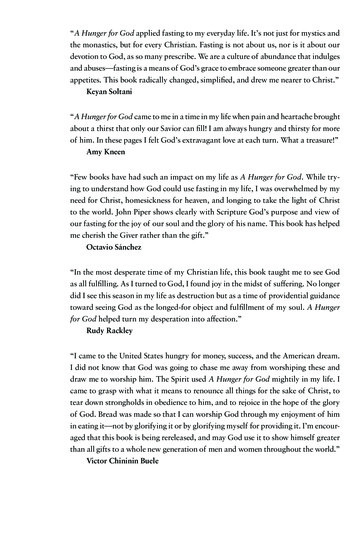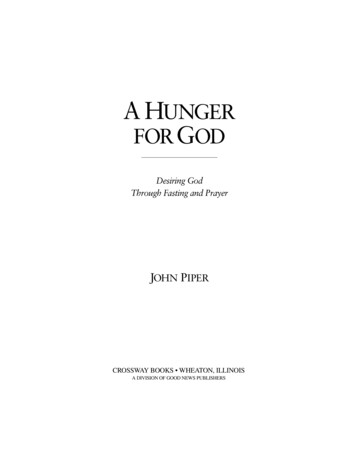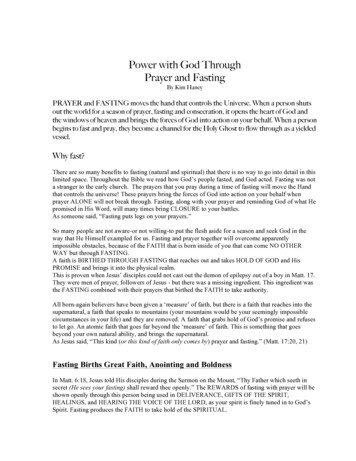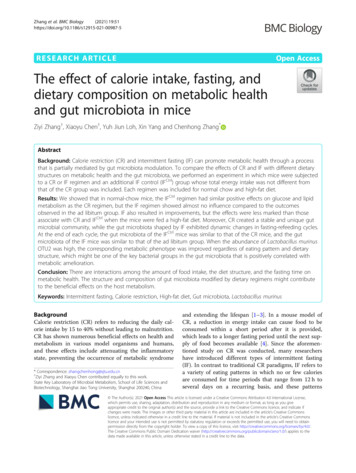
Transcription
JETS 58/4 (2015) 697–707FASTING THAT IS PLEASING TO THE LORD:A NT THEOLOGY OF FASTINGSIGURD GRINDHEIM*In this article I will argue that, as an expression of Christian piety, fasting isonly appropriate in exceptional circumstances. It should not be a habitual expression of devotion to the Lord. Fasting belongs in the OT, but after the coming ofChrist the appropriate sentiment for believers is joy, not grief. That is not to saythat it is wrong for Christians to fast, but that it reflects a state that should not be ahabitual one. Instead of fasting, Christians should express their piety through joyand through sharing their resources with those in need.After a brief overview of fasting in the OT, I will discuss the implications ofJesus’ words about fasting in Mark 2:19–20 par. Next, I will examine the referencesto fasting in the rest of the NT and see if they reflect an exceptional or a habitualpractice. In the final section, I will sketch the outlines of a new kind of fasting.Without ignoring individual differences in expression, emphasis, and focus, myargument will assume the basic unity and coherence of the NT theological witness.I. FASTING IN THE OTIn the OT, fasting frequently accompanies prayer (2 Sam 12:16, 21, 22, 23; Isa58:4; Jer 14:12; 36:6; Joel 1:14; Esth 4:16; Ezra 8:21, 23; Neh 1:4; 2 Chr 20:3). Fasting is associated with mourning (1 Sam 31:13; 2 Sam 1:12; Zech 7:5; Esth 4:3; 9:31;1 Chr 10:12) and humility (1 Kgs 21:27, 29; Isa 58:3, 5; Ps 35:13; 69:11 [ET 69:10];109:24; Ezra 8:21), and is therefore especially appropriate in connection with repentance of sins (1 Sam 7:6; Jer 36:6, 9; Joel 2:12, 15; Jonah 3:5; Neh 9:1).1 Occasionally, fasting is used when seeking direction from the Lord (Judg 20:26–27; Dan9:3).The only required fast in the OT is on the Day of Atonement (Lev 16:31;23:27–32; Num 29:7). When Israel confessed their sins, fasting was the appropriateexpression of their mourning, repentance, and humility.In later Jewish tradition, some Jews were fasting more frequently, apparentlyas a sign of their commitment to God. According to the Gospel of Luke, the Pharisees maintained the practice of fasting two days a week (Luke 18:12).2 The disciples* Sigurd Grindheim is professor of NT at Fjellhaug International University College in Sinsenveien15, 0572 Oslo, Norway.1 David A. Lambert speculates that fasting must be understood against the background of the ancient Near Eastern view of the emperor as the defender of the afflicted and of Israel’s understanding ofGod as the ultimate such defender (Exod 22:22–23). Fasting puts a person in a position of helplessnessand therefore helps make their prayers effective (“Fast, Fasting,” NIDB 2:432).2 Some scholars have suggested that the practice originated as a reaction against the forced Hellenization under Antiochus IV Epiphanes (Felix Böhl, “Das Fasten an Montagen und Donnerstagen: Zur
698JOURNAL OF THE EVANGELICAL THEOLOGICAL SOCIETYof John the Baptist were also pious Jews, and they also considered fasting a sign ofgodly devotion. They were therefore surprised that Jesus’ disciples did not fast(Mark 2:18 par.).II. JESUS’ WORDS ON FASTINGJesus’ response to the Baptist’s disciples is very significant. He says: “Thewedding guests cannot fast while the bridegroom is with them, can they? As long asthey have the bridegroom with them, they cannot fast. The days will come whenthe bridegroom is taken away from them, and then they will fast on that day”(Mark 2:19–20 par.). Jesus compares his presence with the disciples to that of abridegroom. What this means is that he is in the process of fulfilling the OTprophecies of God’s marriage to his people, as the groom’s marriage to his bride.The prophet Isaiah had proclaimed to Israel: “as a bridegroom rejoices over hisbride, so will your God rejoice over you” (Isa 62:5). His prophecy is now beingfulfilled. When Jesus is present, the groom is present to marry his bride.At a wedding celebration, it would certainly be inappropriate for someone tosay: “in honor of the groom, as a sign of my mourning, I am fasting.” Such behavior would of course not be honoring to the groom; it would rather be a seriousinsult. When Jesus is with his people it is the celebration of his wedding party. Inother words, Jesus has not come to invite us to fast, but to feast.The words of Jesus show the radically new and different nature of devotionto the Lord after the coming of Christ. Whereas the OT devout were characterizedby their longing for the presence of God, NT believers are characterized by theirjoy at his presence. OT believers were yearning to experience God’s favor; NTbelievers rejoice that they always enjoy his favor through Jesus Christ.This new and different orientation of piety comes very clearly and appropriately to expression in the new approach to fasting. As Mark has just shown, Jesus’presence brings the forgiveness of sins (Mark 2:1–12), and he invites sinners andtax collectors into his inner circle (Mark 2:13–17). Jesus’ ministry has brought theDay of Atonement to its complete fulfillment. He did not merely provide an annualreminder of the people’s sins, as the Day of Atonement did; he took away our sinforever (Heb 10:3, 10). The presence of Jesus entails the complete removal andforgiveness of sins. Fasting therefore has no place in Jesus’ presence. His presenceis the occasion for joy and exultation.But what about the second part of Jesus’ saying: “the days will come when thebridegroom is taken away from them, and then they will fast on that day” (Mark2:20 par.)? Jesus clearly anticipates a time of fasting for his disciples, the time whenhe “is taken away from them.” Scholars debate whether this refers to the relativelyGeschichte einer pharisäischen Praxis [Lk 18,12],” BZ 31 [1987] 248–50), but we do not know howwidespread this kind of fasting was in the first century. It is also mentioned in the Babylonian Talmud (b.Ta’an. 12a).
FASTING THAT IS PLEASING TO THE LORD699short period between Jesus’ death and his resurrection, or whether it refers to thelong period between Jesus’ death and his second coming.3Both in light of the literary context and in light of the NT theology of Christ’scontinuing presence, the former interpretation is the best. The statement concerning fasting occurs in a context that unpacks the authority of Jesus and the new reality that is communicated through his ministry. He displaces the demons (Mark1:21–28, 39), brings healing (Mark 1:29–34, 39, 40–45, 2:1–12) and cleanness (Mark1:40–45), heals a paralytic (Mark 2:1–12), brings forgiveness of sins (Mark 2:1–12),includes tax collectors and sinners in his fellowship (Mark 2:13–17), and demonstrates his authority over the Sabbath (Mark 2:23–28). Presumably, the audience ofMark’s Gospel would see themselves as the beneficiaries of Christ’s gifts and understand themselves to be in Christ’s presence.4In the Gospel of Matthew, this emphasis on Jesus’ continued presence withhis disciples is made explicit. Jesus is named Emmanuel, “which means ‘God withus’” (Matt 1:23); he promises to be “there among them” when “two or three aregathered in [his] name” (Matt 18:20), and assures his disciples that “I am with youalways, to the end of the age” (Matt 28:20).5 As it is described in Luke-Acts, thiscontinued presence is communicated by the Holy Spirit (Luke 3:16; Acts 1:5, 8; 2:4etc.), who is also known as the Spirit of Jesus (Acts 16:7).Turning to the Gospel of John, it becomes even clearer that the time after theresurrection is not a time of deprivation, but a time when the disciples enjoy an3 For the former interpretation, see Robert H. Gundry, Mark: A Commentary on His Apology for theCross (Grand Rapids: Eerdmans, 1993) 133; Joel Marcus, Mark 1–8: A New Translation with Introduction andCommentary (AB 27; New York: Doubleday, 2000) 237–38; I. Howard Marshall, Commentary on Luke(NIGTC; Grand Rapids: Eerdmans, 1978) 226; John Nolland, Luke 1–9:20 (WBC 35A; Dallas: Word,1989) 248. For the latter interpretation, see Rudolf Pesch, Das Markusevangelium, vol. 1 (HTKNT II/1;Freiburg: Herder, 1976) 175; Joachim Gnilka, Das Markusevangelium, vol. 1 (EKK 2/1; Zurich: Benziger,1978) 115; R. T. France, The Gospel of Mark (NIGTC; Grand Rapids: Eerdmans, 2002) 140; Adela YarbroCollins, Mark: A Commentary (Hermeneia; Minneapolis: Fortress, 2007) 199; W. D. Davies and Dale C.Allison Jr., A Critical and Exegetical Commentary on the Gospel According to Saint Matthew, vol. 1 (ICC; Edinburgh: T & T Clark, 1988) 111; François Bovon, Luke 1: A Commentary on the Gospel of Luke 1:1–9:50(trans. Christine M. Thomas; Hermeneia; Minneapolis: Fortress, 2002) 192; John Piper, A Hunger for God:Desiring God Through Fasting and Prayer (Wheaton, IL: Crossway, 1997) 37–38; Kent D. Berghuis, “Christian Fasting: A Theological Approach” (Ph.D. diss., Trinity Evangelical Divinity School, 2002) 81–93;James R. Edwards, The Gospel According to Mark (PNTC; Grand Rapids: Eerdmans, 2002) 91. JosephWimmer holds the latter interpretation, but does not attribute the concession regarding future fasting tothe historical Jesus (Fasting in the NT: A Study in Biblical Theology [Theological Inquiries; New York: Paulist,1982] 93). Karl T. Schäfer also takes the latter view, but maintains that the fasting is metaphorical, referring to the grief of the disciples in the absence of Jesus (“ Und dann werden sie fasten,” in SynoptischeStudien: Alfred Wikenhauser zum siebzigsten Geburtstag am 22. Februar 1953 [ed. J. Schmid and A. Vögtle;Munich: Zink, 1953] 124–47). Bock takes a middling position, maintaining that fasting will be an appropriate option, not a rule, in the era of the church (Luke, vol. 1: 1:1–9:50 [BECNT; Grand Rapids: Baker,1994] 518). Gundry correctly observes that it is unwarranted to see a reference to fasting on specificdays in the singular “on that day.” The evidence for the church’s fasting on Wednesdays and Fridays istoo late to inform our interpretation of this verse (Mark 133).4 Marcus, Mark 1–8 237–38.5 J. A. Ziesler therefore maintains that the bridegroom saying must antedate the regular practice offasting in the church (“The Removal of the Bridegroom: A Note on Mark II. 18–20 and Parallels,”NTS 19 [1972–73] 190–94).
700JOURNAL OF THE EVANGELICAL THEOLOGICAL SOCIETYeven more intimate fellowship with their Lord. Referring to the time between hisdeath and resurrection, Jesus promises them that the time of their separation willbe short: “a little while, and you will no longer see me, and again a little while, andyou will see me” (John 16:16). This temporary separation is for their good: “I tellyou the truth: it is to your advantage that I go away, for if I do not go away, theAdvocate will not come to you; but if I go, I will send him to you” (John 16:7).After the resurrection, the disciples will be at an advantage compared to their former situation, and they will enjoy a closer relationship with Christ.In this context, John also includes a saying that has much in common withMark 2:20, predicting a time of grief for the disciples: “Very truly, I tell you, youwill weep and mourn, but the world will rejoice; you will have pain, but your painwill turn into joy” (John 16:20). The period of mourning is here the period until thedisciples’ reunion with Christ after his resurrection, as verses 23–24 clearly show.6The history of redemption may be read as the history of God moving closerand closer to human beings. In the old covenant, God was present with his peoplein the Tabernacle and the temple (Exod 20:24; 1 Kgs 8:37–40). Only select individuals experienced that God was “with them” personally (e.g. Josh 3:7; 1 Sam 3:19; 1Kgs 1:37). With the incarnation, God dwelled among his people as a human being:“the Word became flesh and tabernacled among us” (John 1:14 ISV; cf. Matt 1:23).With the giving of the Holy Spirit, God and his Son dwell in believers (John 14:23).The church is therefore God’s dwelling, God’s temple (1 Cor 3:16; Eph 2:21–22).There are therefore strong arguments for the view that Jesus does not envision theperiod of the church as a period of his absence and that this is not a period of fasting.Many scholars hold a different view, however, and they also have good arguments. They maintain that there is ample evidence that the church actually did fast,that the time of the church is a time of the messianic woes, that the phrase “thedays will come” must be understood eschatologically,7 that the church experiencesthe Lord’s absence (even though he is also present through the Spirit), and thatMatthew specifically describes the time of the church as the time of the bridegroom’s absence (Matt 25:1–13).8The last of these arguments puts too much weight on a subordinate detail inthe parable of the ten virgins. Interpretation of parables requires restraint in readingtheological meaning into the parable’s individual elements. Most of the details of aparable do not serve to make a theological point, but to give vividness to the story.The point of the parable of the ten virgins is to exhort believers to watchfulness.Other details do not have any theological significance. It is not significant, for ex6 Raymond E. Brown, The Gospel According to John (XIII–XXI): Introduction, Translation and Notes (AB29A; New York: Doubleday, 1970) 730; D. A. Carson, The Gospel According to John (PNTC; Grand Rapids:Eerdmans, 1991) 543; Craig S. Keener, The Gospel of John, vol. 2 (Peabody, MA: Hendrickson, 2003) 1044;Andreas J. Köstenberger, John (BECNT; Grand Rapids: Baker, 2003) 477; J. Ramsey Michaels, The Gospelof John (NICNT; Grand Rapids: Eerdmans, 2010) 843.7 Cf. Isa 39:6; Jer 7:32; 9:24; 16:14; 19:6; 23:5, 7; 28:52 LXX; 30:18 LXX; 31:12 LXX; 37:3 LXX;38:27, 31, 38 LXX; Amos 4:2; 8:11; 9:13; Luke 17:22; 21:6; 23:29; Heb 8:8.8 For references, see note 3.
FASTING THAT IS PLEASING TO THE LORD701ample, that the virgins play the role of bridesmaids even though the stock metaphor for the church is that of the bride (cf. Eph 5:25–27).9That “the days will come” evokes an eschatological event does not mean thatit has to refer to the tribulations of the church. Christ’s death is the ultimate eschatological event, and his earthly ministry is frequently announced with the samephrase (Jer 23:5; 38:31 LXX; Heb 8:8).True, believers in the period of the church yearn for the visible appearance ofthe Lord (1 Cor 16:22; Rev 22:20), but do they therefore have a better reason tofast than the disciples had at the time of Jesus’ earthly ministry? The disciples alsohad reason to look forward to the consummation of the kingdom (Matt 6:10), butthe joy of the Lord’s presence was the predominant feeling. In that respect, believers in the church age are not in a worse position than they were. To the contrary,they enjoy a closer relationship to Christ than they did (see above).The observation that the church age is an age of tribulation also does notwarrant the conclusion that fasting is appropriate. When believers experience tribulation, it is a consequence of their union with Christ. Suffering is therefore not asign of distance from the Lord, but a sign of intimacy between the Lord and hisfollowers (Rom 8:17; 2 Cor 1:5; 4:10–11; Phil 3:10). When Paul shares the afflictions of Christ, he considers it an occasion to rejoice (Col 1:24), and Peter exhortssuffering believers: “rejoice insofar as you are sharing Christ’s sufferings, so thatyou may also be glad and shout for joy when his glory is revealed” (1 Pet 4:13).III. FASTING IN THE REST OF THE NTIf the time of the church is not the time of separation that Jesus anticipated inMark 2:20 par., how are we to understand the fact that the early church practicedfasting? It bears repeating that this practice is never mandated in the NT. From thesecond century, there is firm evidence that Christians fasted on Wednesdays andFridays (Did. 8.1), but there is no evidence of a similar practice in the earliestchurch.Apart from Mark 2:20 par, which probably refers to the time between thecrucifixion and the resurrection or Pentecost, Jesus never encourages fasting. Somemanuscripts include a reference to fasting when Jesus’ disciples had been unable tocast out a demon. After casting it out, Jesus said to them: “this kind can come forthby nothing, but by prayer and fasting” (Mark 9:29 par. KJV; cf. ISV; NKJV). But9 For our present purposes, the discussion of whether the oil should be given a theological interpretation need not detain us (cf. W. D. Davies and Dale C. Allison Jr., A Critical and Exegetical Commentary onthe Gospel According to Saint Matthew [ICC; Edinburgh: T&T Clark, 1997] 3:396–97; Klyne R. Snodgrass,Stories with Intent: A Comprehensive Guide to the Parables of Jesus [Grand Rapids: Eerdmans, 2008] 515). It haslong been the consensus in NT studies that parables only make one single point, but that view was anoverreaction against the earlier, allegorical methods of interpretation. Parables may have more than asingle point, but it is a mistake to find too many points of theological correspondence. For a discussionof the hermeneutics of the parables, see Craig Blomberg, Interpreting the Parables (Downers Grove, IL:IVP, 1990); Arland J. Hultgren, The Parables of Jesus: A Commentary (Grand Rapids: Eerdmans, 2000) 12–19.
702JOURNAL OF THE EVANGELICAL THEOLOGICAL SOCIETYthe words “and fasting” are not found in the most reliable Greek manuscripts ofthe NT, and most modern translations rightly omit them.10 The words were probably added by Christian scribes later, at a time in church history when there was considerable emphasis on fasting.11In the history of the church, Jesus’ example of fasting has been used as a motivation for Christians to fast as well. Jesus spent forty days in the wilderness inorder to be tempted by the devil (Matt 4:2 par.), but that was not something Jesusdid in order for us to follow in his footsteps; it was something he did in our place.Jesus was baptized by John, not because Jesus was a sinner, but because he was oursubstitute. As our representative, he was also tested by Satan. His temptations recallIsrael’s temptations in the wilderness and show us that Jesus was tested as the idealIsraelite. Where Israel failed, Jesus prevailed.12 While Jesus’ perseverance in temptation is a great example for us, his baptism and temptation were part of his vicariousministry. His forty-day fast does therefore not serve as an example for us to imitate.After this test which Jesus went through in our place, his ministry was notcharacterized by fasting. On the contrary, he was known for his feasts, feasts wherehe invited all kinds of people, people that were not allowed in good society, prostitutes and tax collectors, the dregs of society, individuals that no one would be seenaround if they cared about their own reputation. And these feasts were so characteristic of Jesus’ ministry that people called him “a glutton and a drunkard, a friendof tax collectors and sinners” (Matt 11:19).Nevertheless, in the Gospel of Matthew, Jesus appears to assume that his disciples will be fasting. He even gives directions for how to do it: “whenever you fast,do not look dismal, like the hypocrites, for they disfigure their faces so as to showothers that they are fasting. Truly I tell you, they have received their reward. Butwhen you fast, put oil on your head and wash your face, so that your fasting may beseen not by others but by your Father who is in secret; and your Father who sees insecret will reward you” (Matt 6:16–18).10 The words “and fasting” () are attested in the apparent text of the Chester Beatty papyrus (p45), the second hand of Codex Sinaiticus, Codex Alexandrinus, Codex Ephraemi, Codex BezaeCantabrigiensis, and the Majority Text. The words are not included in Codex Vaticanus or in the originalhand of Codex Sinaiticus.11 Similar additions (with even poorer attestation) are also found in Acts 10:30; 1 Cor 7:5. Since thereference to fasting is included in the majority of witnesses to Mark 9:29, R. T. France argues that it maybe original. He maintains that a scribe could have omitted the words to counter an overemphasis onfasting and to bring the verse in harmony with 2:19 (Mark 361). His explanation is possible, but it isbased on the assumption that the scribes responsible for Codex Sinaiticus and Codex Vaticanus represented an ideology that ran counter to the predominant trend in the early church. There is no evidencethat these scribes were against fasting, but there is ample evidence for the added emphasis on fasting inthe early church. It is therefore more likely that the reference to fasting was added in the later manuscripts. The United Bible Society prefers the reading without the reference to fasting and gives thisreading the highest probability rating (cf. Bruce M. Metzger, A Textual Commentary on the Greek NT [4threv. ed.; New York: United Bible Societies, 1994] 85; similarly Craig A. Evans, Mark 8:27–16:20 [WBC34B; Nashville: Thomas Nelson, 2001] 47).12 See especially Birger Gerhardsson, The Testing of God’s Son (Matt. 4:1–11 & par.): An Analysis of anEarly Christian Midrash (ConBNT 2; Lund: Gleerup, 1966).
FASTING THAT IS PLEASING TO THE LORD703However, it is not obvious how much we should read into this statement. InMatthew’s Gospel, Jesus also appears to presuppose that his audience keeps theSabbath (Matt 24:20), pays the temple tax (Matt 17:24–27),13 and even observes thecommandments of the scribes and the Pharisees (Matt 23:1–3). Perhaps the audience of Matthew’s Gospel was characterized by a Jewish ethos or perhaps Matthewhas preserved more of the Jewish color of Jesus’ teaching.14 In any case, these references do not constitute a prescription. As for the references to fasting in Matt6:16–18, Jesus’ point is not to instruct his disciples to fast, but to warn them againsthypocrisy. Fasting evidently offers an example of a practice that is easily misused ina hypocritical way.Paul also has a stern warning against misuse of fasting in Col 2:20–23: “if withChrist you died to the elemental spirits of the universe, why do you live as if youstill belonged to the world? Why do you submit to regulations, ‘Do not handle, Donot taste, Do not touch’? All these regulations refer to things that perish with use;they are simply human commands and teachings. These have indeed an appearanceof wisdom in promoting self-imposed piety, humility, and severe treatment of thebody, but they are of no value in checking self-indulgence.” The word that is translated “humility” (; v. 18) may refer to ascetic practices, such asfasting (Herm. Vis. 3.10.6; Herm. Sim. 5.3.7).15 Paul’s mention of “severe treatmentof the body” leads to the conclusion that he has such practices in mind here.16Contrary to popular belief, these activities are not of any help in restraining fleshlyindulgence.17 No one should think that fasting makes them more spiritual. It doesnot. If fasting is done because it is believed that fasting in and of itself accomplishes something spiritual, fasting is downright wrong.Nevertheless, there are two instances in the book of Acts where the disciplesare seen to be fasting.18 While the disciples were fasting, the Holy Spirit told them13 For a different interpretation, see Graham N. Stanton, A Gospel for a New People: Studies in Matthew(Edinburgh: T&T Clark, 1992) 203–6.14 On Matthew’s relation to Judaism, see Andrew Overman, Matthew’s Gospel and Formative Judaism:The Social World of the Matthean Community (Minneapolis: Fortress, 1990); Stanton, Studies in Matthew; Anthony J. Saldarini, Matthew’s Christian-Jewish Community (CSHJ; Chicago: University of Chicago Press,1994); David C. Sim, The Gospel of Matthew and Christian Judaism: The History and Social Setting of the MattheanCommunity (Studies in the NT and Its World; Edinburgh: T&T Clark, 1998).15 The cognate verbis used with specific reference to fasting in Ps 34:11 LXX; Isa 58:3, 5LXX; Jdt 4:9; cf. also 2 Esd 8:21.16 Similarly, James D. G. Dunn, The Epistles to the Colossians and to Philemon (NIGTC; Grand Rapids:Eerdmans, 1996) 178; Douglas J. Moo, The Letters to the Colossians and to Philemon (PNTC; Grand Rapids:Eerdmans, 2008) 226; Jerry L. Sumney, Colossians: A Commentary (NTL; Louisville: Westminster JohnKnox, 2008) 55; David W. Pao, Colossians and Philemon (ZECNT; Grand Rapids: Zondervan, 2012) 188.17 For a defense of this translation, see J. B. Lightfoot, St. Paul’s Epistles to the Colossians and Philemon(8th ed.; London: Macmillan, 1886) 204–8.18 Paul also mentions fasting in 2 Cor 6:5; 11:27. In both cases, the context is a hardship catalogue,and it is not clear whether the reference is to voluntary or involuntary fasting. Even if it is voluntaryfasting, the point is not that Paul has excelled in pious exercises (such an insistence would run counterto Paul’s overall argument). Rather, fasting is another example of Paul’s acquaintance with suffering forthe sake of Christ, perhaps as a consequence of not accepting monetary support from the Corinthians.Similarly, Victor Paul Furnish, II Corinthians: Translated with Introduction, Notes and Commentary (AB 32A;
704JOURNAL OF THE EVANGELICAL THEOLOGICAL SOCIETYto send Saul and Barnabas out on their first missionary journey (Acts 13:2–3). Withprayer and fasting, Paul and Barnabas prepared to leave the church in Antioch inSyria (Acts 14:23).Even though there are no regulations concerning fasting in the NT, these examples show that there are situations in which fasting is legitimate. Both the instances in Acts occur in a context where the disciples are praying and seeking guidance from the Lord. Viewed in light of Jesus’ words in Mark 2:19–20, therefore, itwould appear that fasting has its place when believers experience uncertainty andhave a special need for direction from the Lord.19 Such fasting seems to have hadits place when believers found themselves in exceptional circumstances.Many scholars also think that Paul’s three days without food and drink (Acts9:9) is an example of Christian fasting. Some even find here the origin of the laterpractice of fasting three days before baptism (Did. 7.4).20 Luke does not explicitlysay whether Paul’s fasting was an act of penitence or whether it was an involuntarypunishment inflicted by God. The context in which the story is told, however,shows that we should think of it more in the latter sense.21 Being three days without sight, Paul was in darkness, which in Luke’s account represents alienation fromGod. In Luke’s third version of Paul’s Damascus experience, Paul gives his accountto Herod Agrippa and associates his experience with turning from darkness to light.The Lord told him: “I will rescue you from your people and from the Gentiles—towhom I am sending you to open their eyes so that they may turn from darkness tolight and from the power of Satan to God, so that they may receive forgiveness ofsins and a place among those who are sanctified by faith in me” (Acts 26:17–18).This perspective is present in the version in Acts 9:1–19 as well. When Ananiasvisits Paul, reception of the Holy Spirit and regaining of sight coincide (Acts 9:17–18).Through the Holy Spirit, Christians enjoy an intimate relationship with Christ.The baseline for Christian piety must therefore be that fasting is not an appropriateexpression of Christian devotion to the Lord. NT differs from OT piety in thatGod has now come near in his Son and through his Holy Spirit. Even though believers long for the Second Coming of Christ and the visible manifestation of hisrule (Matt 6:10; 1 Cor 16:22; Rev 22:20), NT piety is characterized by intimacy, notNew York: Doubleday, 1984) 518; Margaret E. Thrall, A Critical and Exegetical Commentary on the SecondEpistle to the Corinthians (ICC; Edinburgh: T&T Clark, 2000) 2:747. The widow Anna is an example ofOT piety (Luke 2:37).19 Scot McKnight describes fasting for this purpose (Fasting: Fasting as Body Talk in the Christian Tradition [Nashville: Thomas Nelson, 2008] 47–49).20 Hans Conzelmann, Acts of the Apostles (trans. James Limburg, A. Thomas Kraabel, and Donald H.Juel; Hermeneia; Minneapolis: Fortress, 1987) 72; Joseph A. Fitzmyer, The Acts of the Apostles: A NewTranslation with Introduction and Commentary (AB 31; New York: Doubleday, 1998) 426; Richard I. Pervo,Acts (Hermeneia; Minneapolis: Fortress, 2008) 242.21 F. F. Bruce is on the right track when he observes: “There is no need to regard his abstinence asan early instance of fasting before baptism; it was probably the result of shock” (The Book of the Acts[NICNT; Grand Rapids: Eerdmans, 1988] 185).
FASTING THAT IS PLEASING TO THE LORD705distance.22 The predominant sentiment of believers living in the age of fulfillment isjoy, not grief (Phil 3:1; 4:4–7; 1 Thess 5:16). They therefore have no occasion forfasting.Christians who long for a deeper relationship with the Lord should thereforenot be directed to fasting. In accordance with his promise, Christ is still presentwith his people today. Believers may enjoy his presence through his word, throughprayer, and through the community of the church.In the NT era, fasting is not even the natural way to express one’s repentance.23 Joy is so overwhelmingly the characteristic sentiment of the new era thateven repentance may be expressed through feasting and joy. In the parable of theprodigal son, the implicit call to the Pharisees to repent is phrased as an invitationto join a party: “we had to celebrate and rejoice, because this brother of yours wasdead and has come to life; he was lost and has been found” (Luke 15:32).24 Repentance means that a person’s mind is realigned, so that it conforms to the mind ofGod and rejoices in the salvation brought by Christ.IV. A NEW KIND OF FASTINGWhen some Christian leaders today call the church to renew the practice offasting, they often seem to be motivated by the laudable desire to set Christians freefrom slavery to the pleasures of this world. In his very valuable book, A Hunger forGod, John Piper writes
Fasting puts a person in a position of helplessness and therefore helps make their prayers effective (“Fast, Fasting,” NIDB 2:432). 2 Some scholars have suggested that the prac
